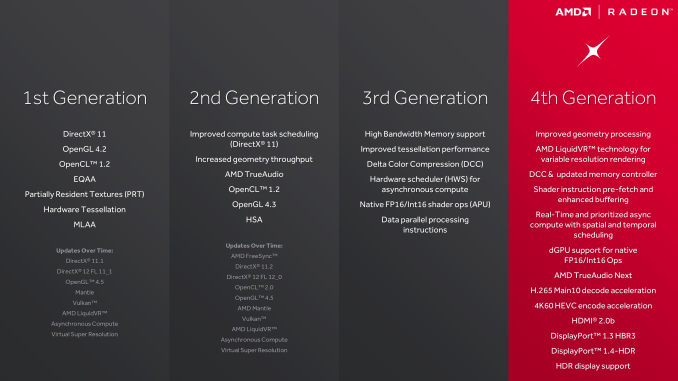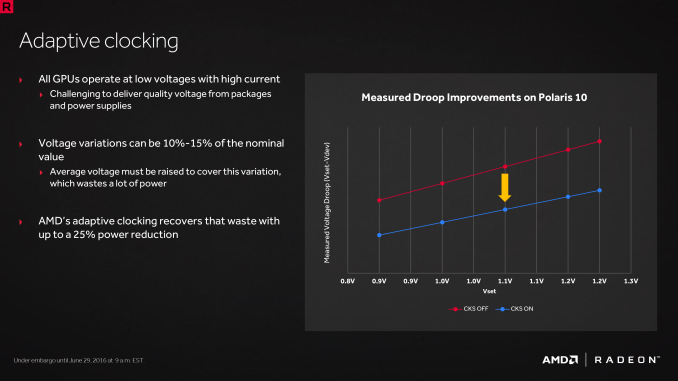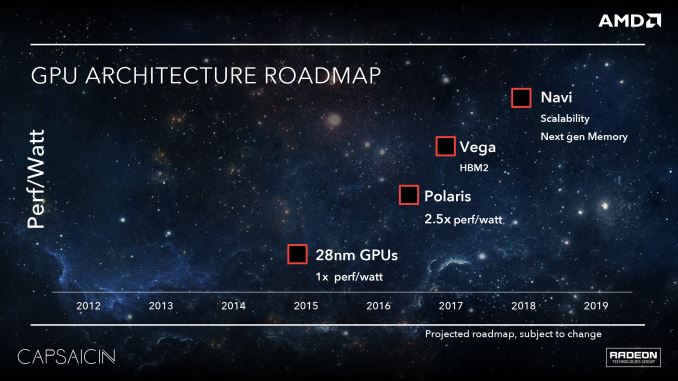The AMD Radeon RX 480 Preview: Polaris Makes Its Mainstream Mark
by Ryan Smith on June 29, 2016 9:00 AM ESTAMD's Path to Polaris
With the benefit of hindsight, I think in reflection that the 28nm generation started out better for AMD than it ended. The first Graphics Core Next card, Radeon HD 7970, had the advantage of launching more than a quarter before NVIDIA’s competing Kepler cards. And while AMD trailed in power efficiency from the start, at least for a time there they could compete for the top spot in the market with products such as the Radeon HD 7970 GHz Edition, before NVIDIA rolled out their largest Kepler GPUs.
However I think where things really went off of the rails for AMD was mid-cycle, in 2014, when NVIDIA unveiled the Maxwell architecture. Kepler was good, but Maxwell was great; NVIDIA further improved their architectural and energy efficiency (at times immensely so), and this put AMD on the back foot for the rest of the generation. AMD had performant parts from the bottom R7 360 right up to the top Fury X, but they were never in a position to catch Maxwell’s efficiency, a quality that proved to resonate with both reviewers and gamers.
The lessons of the 28nm generation were not lost on AMD. Graphics Core Next was a solid architecture and opened the door to AMD in a number of ways, but the Radeon brand does not exist in a vacuum, and it needs to compete with the more successful NVIDIA. At the same time AMD is nothing if not scrappy, and they can surprise us when we least expect it. But sometimes the only way to learn is the hard way, and for AMD I think the latter half of the 28nm generation was for the Radeon Technologies Group learning the hard way.
So what lessons did AMD learn for Polaris? First and foremost, power efficiency matters. It matters quite a lot in fact. Every vendor – be it AMD, Intel, or NVIDIA – will play up their strongest attributes. But power efficiency caught on with consumers, more so than any other “feature” in the 28nm generation. Though its importance in the desktop market is forum argument fodder to this day, power efficiency and overall performance are two sides of the same coin. There are practical limits for how much power can be dissipated in different card form factors, so the greater the efficiency, the greater the performance at a specific form factor. This aspect is even more important in the notebook space, where GPUs are at the mercy of limited cooling and there is a hard ceiling on heat dissipation.
As a result a significant amount of the work that has gone into Polaris has been into improving power efficiency. To be blunt, AMD has to be able to better compete with NVIDIA here, but AMD’s position is more nuanced than simply beating NVIDIA. AMD largely missed the boat on notebooks in the last generation, and they don’t want to repeat their mistakes. At the same time, starting now with an energy efficient architecture means that when they scale up and scale out with bigger and faster chips, they have a solid base to work from, and ultimately, more chances to achieve better performance.
The other lesson AMD learned for Polaris is that market share matters. This is not an end-user problem – AMD’s market share doesn’t change the performance or value of their cards – but we can’t talk about what led to Polaris without addressing it. AMD’s share of the consumer GPU market is about as low as it ever has been; this translates not only into weaker sales, but it undermines AMD’s position as a whole. Consumers are more likely to buy what’s safe, and OEMs aren’t much different, never mind the psychological aspects of the bandwagon effect.
Consequently, with Polaris AMD made the decision to start with the mainstream market and then work up from there, a significant departure from the traditional top-down GPU rollouts. This means developing chips like Polaris 10 and 11 first, targeting mainstream desktops and laptops, and letting the larger enthusiast class GPUs follow. The potential payoff for AMD here is that this is the opposite of what NVIDIA has done, and that means AMD gets to go after the high volume mainstream market first while NVIDIA builds down. Should everything go according to plan, then this gives AMD the opportunity to grow out their market share, and ultimately shore up their business.
As we dive into Polaris, its abilities, and its performance, it’s these two lessons we’ll see crop up time and time again, as these were some of the guiding lessons in Polaris’s design. AMD has taken the lessons of the 28nm generation to heart and have crafted a plan to move forward with the FinFET generation, charting a different, and hopefully more successful path.
Though with this talk of energy efficiency and mainstream GPUs, let’s be clear here: this isn’t AMD’s small die strategy reborn. AMD has already announced their Vega architecture, which will follow up on the work done by Polaris. Though not explicitly stated by AMD, it has been strongly hinted at that these are the higher performance chips that in past generations we’d see AMD launch with first, offering performance features such as HBM2. AMD will have to live with the fact that for the near future they have no shot at the performance crown – and the halo effect that comes with it – but with any luck, it will put AMD in a better position to strike at the high-end market once Vega’s time does come.













449 Comments
View All Comments
just4U - Wednesday, June 29, 2016 - link
yeah.. competes with a 970 on some games.. and the reference 980 on others. Was a good card.akamateau - Wednesday, June 29, 2016 - link
Seriously?2 RX 480 in Crossfire CRUSHES GTX 1080!!!!
rtflol
AntDX316 - Thursday, June 30, 2016 - link
The hype was fake.I mean honestly releasing a 14nm flagship slower than their previous gen is a step in the wrong direction. I wouldn't be surprised if they just release an $800 version of the 14nm in early 2017 with masssive power. They just need more time to get their fabrications correct. I assume there could be some unforeseen problems and if the problems do arise with the $200 version it won't leak into the common video card world. It would be kept rare and quiet so that stuff can be fixed for their $800 flagship.
slickr - Thursday, June 30, 2016 - link
This isn't a flagship card you moron! This is a mid range mainstream card, created specifically for the mass market. Their flagship card is coming in 2017, its Vega and its got HBM2, matured 14nm process, 4000+ stream processors, etc...Yojimbo - Thursday, June 30, 2016 - link
It's not a flagship card. They don't have a new flagship card so they tried to hype their mainstream card with "This is what you really want/need!" The recent trend is for gamers to buy more expensive cards, not cheaper ones, though, so in my opinion unless the economy tanks it's a bad strategy.If it performed 20% better or they sold it for $160 instead of $200 it would be all the things they tried to hype it as being. But as it is, it just looks like the first 14/16nm mainstream card to market. No more, no less. It's a solid card but it'll never be that impressive to launch a mainstream card that slots right into what the competition will offer in 1 or 2 months while leaving the rest of the market uncovered.
Gigaplex - Thursday, June 30, 2016 - link
Next you'll be telling us that the NVIDIA 750 Ti was the Maxwell flagship. It came first, that does not make it a flagship.ihatenividiaastheyareaholes - Saturday, July 9, 2016 - link
heres a thought how about people stop arguaing about this and wake the fuck up to what is going on that being the consoles trying to knock pc of its glorious pedastelIronTed - Wednesday, June 29, 2016 - link
You sir are a moron.slickr - Thursday, June 30, 2016 - link
The 390 easily beast the gimped and fraudulent 970 3.5GB trash for LESS money. The trash 970 still costs around $300, in extremely rare cases $280 for only 3.5GB.The RX 480 costs $200 or $240, consumes less, has full DX12 support, its cooler, quieter, overclocks a lot more.
sonicmerlin - Friday, July 1, 2016 - link
The reference cards don't overclock at all. If you want an AIB card expect to pay significantly more.